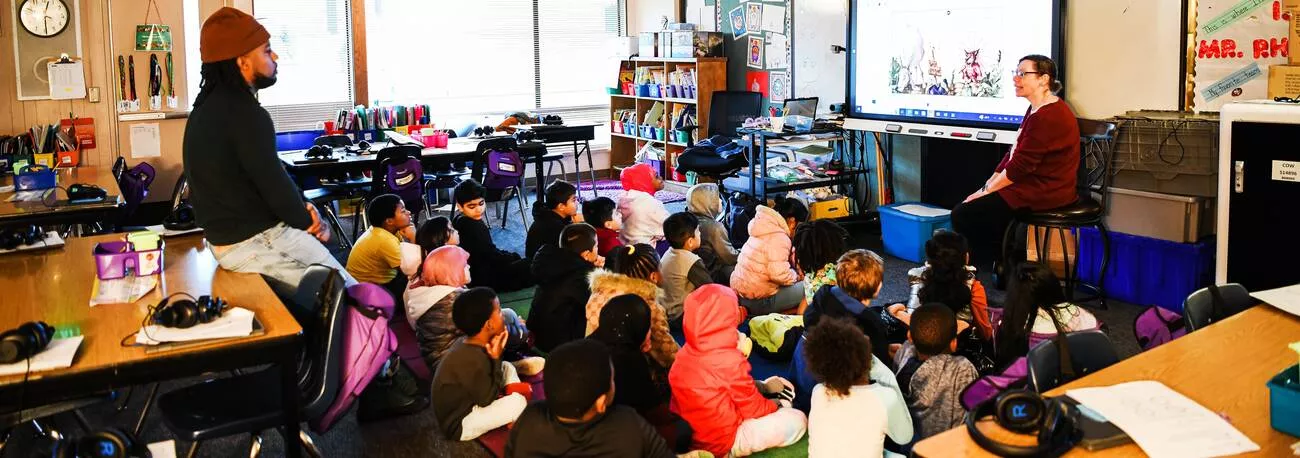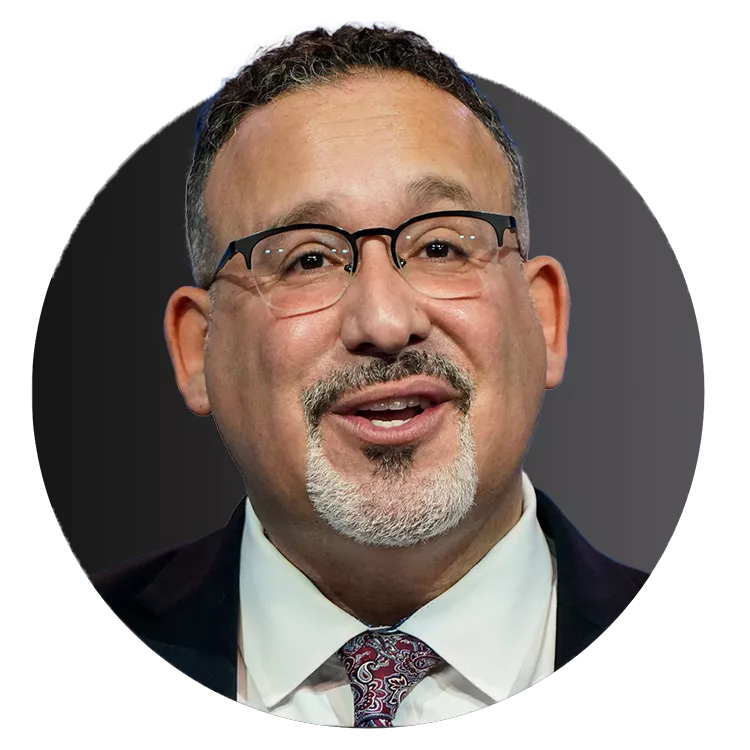Introduction
How Funds are Used
Implementation Grant Program
The passage of the historic American Rescue Plan Act (ARPA) dedicated more than $170 billion in funding to K–12 schools and higher education institutions, providing the National Education Association (NEA) with an unprecedented opportunity to reshape the future of public education for students, educators, and communities across the country.
To ensure NEA members have a say in how ARPA funds are used, the NEA created the School Rescue Funds (SRF) Implementation Grant Program to provide state affiliates with dedicated staff, expertise, resources, and networking opportunities to create safe, just, and equitable learning environments for every student across race, place, background, and ability.
Through this program, the NEA is providing state affiliates up to $100,000 per year for up to three years or until December 31, 2024. State affiliates must use these funds to hire or backfill a coordinator dedicated to the implementation of ARPA funds in their states.
Collectively, the state coordinators form the SRF Coordinators Network. The work of the state coordinators has evolved over the course of the implementation campaign—from demanding that school districts meaningfully consult with NEA members on the use of funds, as required, to identifying alternative funding sources to sustain NEA member priorities once the federal dollars expire.
Goals of the Grant Program
Share the power and effectiveness of educator solutions to address COVID-19 opportunity gaps and bridge toward lasting education equity.
Ensure educator voice is an essential component of securing the ARPA resources that schools and students need and receive.
Seize this opportunity to show existing and potential members proof of their power to make change and the power of belonging to America’s largest labor union.
Seize on opportunities created by the American Rescue Plan Act to bolster champions for public education.
Coordinators Network
By the Numbers
38
33
2.5K+
681K+
2.7K+
$2.75 Billion+
School Rescue Funds Digital Campaign
In 2022, the NEA released a series of videos highlighting real stories that features the voices of NEA members who have advocated within their local associations for ARPA funds to be allocated where they are needed most—toward educator retention bonuses, reduced class sizes, additional social-emotional learning staff in schools, and more.
The series was part of a national advertising campaign that included more than $1 million in digital advertising to bolster ARPA’s champions and hold accountable those unwilling to address historic inequities. The videos display the importance of educator voices in funding and policy decisions and the power of the union, highlighting key stories that emphasize the impact of school rescue funds on districts throughout the country.
Our Voices, Our Stories
ISSUE HIGHLIGHTS
States and school districts were required to set aside a portion of their ARPA funds to address academic recovery, which included summer learning and comprehensive afterschool programs. In addition, states and school districts made funding decisions in collaboration with NEA affiliates to invest in tutoring programs, mental health supports, social and emotional learning, smaller class sizes, and preschool expansion. In July, an Education Week Research Center survey of teachers, school leaders, and district administrators found that “70 percent said they are confident their students will end the 2023–2024 school year on grade level. Of that 70 percent, 25 percent said they were either “extremely” or “very” confident.”
COVID-19 prompted new attention and dedication to ensuring the safety of students and staff. ARPA funds are being used around the country to upgrade facilities to improve health and safety infrastructure in schools, including ventilation systems and mold remediation. According to an Education Week article published on October 5, 2023, a key conclusion from a recently published study of the far-reaching effects of school district investments in school facilities is that student test scores can be expected to rise significantly after the district invests to upgrade HVAC systems and roofs, especially in historically under-resourced districts and those marginalized districts serving students of color. The paper concludes that students benefit most when degraded facilities get better.
ARPA funds have been used to support recruitment and retention programs to address staff shortages among educators, which are impacting school districts nationwide. According to a U.S. Department of Education May 15, 2023, press release, as of July 2022, with the help of these funds, the number of school social workers is up 48 percent, the number of school nurses is up 42 percent, and the number of school counselors and school psychologists are each up 10 percent—in comparison to the pre-pandemic period.
Our members have won retention bonuses and salary schedule increases for educators, including classroom teachers, education support professionals, and specialized instructional support personnel.
Reticence by school districts to use nonrecurring funds for recurring expenses is the primary challenge that local education associations face. Many local education associations have challenged the reticence and won at the bargaining table by mobilizing educators, parents, and students on their behalf.
Local and State Wins
As the SRF Coordinators Network has expanded, state and local affiliates have been achieving success across the country. Here are highlights of these success stories.

In Washington, the state utilized ARPA funds and tapped the Washington Education Association to create a “for educators, by educators” union-run teacher residency program. This historic first-of-its-kind program deserves national attention for two reasons. First, the ARPA ESSER funds were invested as intended—to make long-term transformational changes in public schools in Washington State. Second, the WEA recognized from the outset the need to identify and secure funding to sustain the program beyond the ESSER funds’ expiration. The program will transition to an apprenticeship model in the 2025–2026 school year, with funding from the U.S. Department of Labor.
The WEA created this program to prepare educators to serve Washington’s diverse learners and communities while also dismantling institutional systems that cause harm to students and educators. In particular, the program will help address educator shortages in special education. In its first year, the program has 16 residents participating across three sites: Federal Way, Mukilteo, and Walla Walla. The WEA intends to double the number of residents participating in the 2024–2025 academic year.
This teacher residency program offers a model for other states, demonstrating how to hold high standards for residents while also reducing barriers to entry into the teaching profession.
Michigan Education Association (MEA) member Karen Storey spent over a decade creating a therapy dog program for her district in Brighton, Michigan. The work of the Pack of Dogs program has drawn local and national coverage.
With Pack of Dogs serving as the model, districts in Michigan have expanded the program using ARPA funds. They have also utilized ARPA funds to expand the program, implementing it in Colorado, Oklahoma, and Virginia.
Organizing Wins
Organizing has been critical to the success of the SRF implementation campaign. NEA experts and SRF coordinators have shared trainings and resources with fellow coordinators, showcasing successful advocacy for ARPA funds. These trainings have highlighted best practices, introduced coordinators to work being done by member leaders as part of NEA’s Year-Round Organizing program, and led to action that has seen tremendous impacts around the country.





Training and Support
The SRF Implementation Grant Program places a significant emphasis on training and building the capacity of the Network to more effectively advocate for modern, safe, supportive, and future-focused public education and achieve positive outcomes in participating states.
The Network’s training programs are tailored to provide coordinators with the knowledge and skills they need to navigate the complexities of education policy, effectively advocate for member priorities, and construct a public narrative that highlights the successful uses of the school rescue funds. Coordinators have received guidance on building strategic partnerships, conducting data-driven research, and engaging with diverse stakeholders, from community leaders to policymakers. These resources empower them to assist state and local affiliates, members, and school districts in making informed decisions.
The Network also offers ongoing support to coordinators, including access to resources, expert guidance from the NEA and partner organizations, and a collaborative community where coordinators can exchange best practices and seek advice from peers. Coordinators meet biweekly for training sessions and presentations from policy and skill experts, and they share threats, opportunities, and best practices.
It is through this combination of training, resources, and ongoing support that NEA empowers coordinators to be effective and passionate advocates for equitable, safe, healthy, and inclusive public schools.
In-Person Convenings
The SRF Coordinators Network has hosted three in-person meetings of state coordinators. These biannual networking and training opportunities have been critical to coordinator development.
At each convening, coordinators heard from senior Biden Administration leaders—including Deputy Assistant Secretary of Education Adam Schott, former Assistant Secretary of Education James Lane, and National Coordinator of ARPA for the White House Gene Sperling. These conversations allowed coordinators to share directly with senior education policy leaders about their successes and challenges as well as how the Biden Administration can help ensure school rescue funds promote the interests of students, educators, schools, and the administration. Coordinators also stressed the importance of meaningful consultation with local education associations and educators as required by ARPA.
“Meaningful consultation is now on my radar, thanks to you.”
—Gene Sperling, National Coordinator of ARPA, The White House
Coordinators received policy briefings and training in areas including member organizing, digital communications, collective bargaining, data analysis, and sustainability of funding from NEA experts and partner organizations, such as the Council of Chief State School Officers (CCSSO). Each convening builds on the knowledge and training gained at previous convenings, forming a strong foundation for coordinators as they continue to advocate for effective use and allocation of school rescue funds.
The ability to sustain wins will depend on convincing the public that school rescue funds are necessary and are being used to make a difference for students and schools across the country. The 2024 election is where that debate will play out. To win the public narrative and the public’s support for education funding, coordinators received additional training on story development, collection, and advocacy organizing at the most recent convening in October 2023.
Looking Forward
As we approach the third anniversary of the passage of the American Rescue Plan Act and the deadline to use ARPA funds, the SRF Coordinators Network is poised to ensure continued success in the use of ARPA funds, highlighting critical wins, sustaining successful programs, and advocating for sufficient education funding.
What's to Come
The Network recognizes the importance of continuous advocacy to secure sustainable funding for education. As ARPA funds are non-recurring, the SRF Coordinators Network will concentrate on collaboration with local, state, and national entities to advocate for the long-term financial stability of our educational institutions.
To maximize the impact of ARPA funds and set the stage for sustainable funding, the Network will continue to highlight innovative and evidence-based uses of funds. Recognizing the diverse needs of states, the Network will prioritize identifying successful models and strategies that can be adapted and implemented effectively.
As the September 2024 deadline for using ARPA funds approaches, the Network will continue to hold districts accountable for investing every dollar effectively in the interest of our students and members. The Network will work to ensure this historic investment won’t go to waste by continuing to monitor and evaluate how funds are utilized with a focus on unexpended funds.
Further, the Network will concentrate on sustainable funding mechanisms for programs that may otherwise be discontinued when ARPA funds expire. By highlighting existing federal programs and funding sources and assisting in identifying new sources, states and districts will be better prepared to maintain support for students and educators.
Approaching the 2024 election, the Network recognizes the significance of educating the public about the vital role that ARPA funds played in helping public schools recover from the pandemic. Accordingly, plans include expanding outreach efforts, deepening story collection and development, and raising awareness of the impact this historic policy has on students.


